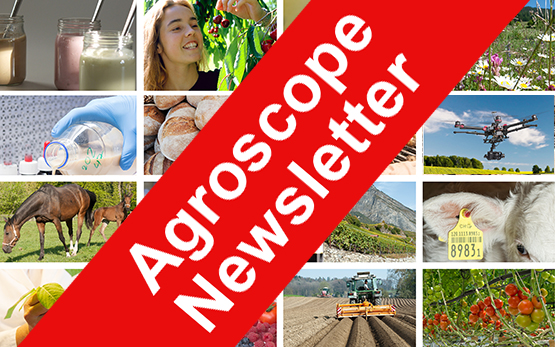Wild Bees Fly for Research
Zurich-Reckenholz, 26.05.2020 - What stresses wild bees? Is it certain plant-protection products, the absence of nutrient-rich foods – or a combination of both factors? Together with research partners throughout Europe, Agroscope is investigating these issues.
Of the total proceeds from agriculture in Switzerland, around CHF 350 million a year are only generated due to the pollination performance of honeybees and wild bees. Many of Switzerland’s over 600 wild-bee species often make as important a contribution here, as do honeybees – hence, the protection of wild bees is also crucial for the farming sector. Insect numbers have declined worldwide in many regions, and wild-bee populations are also under pressure. But what exactly is harming wild bees? As part of an EU project and together with 42 partner organisations (www.poshbee.eu), Agroscope experts investigate possible stress factors and their interactions. The aim: to improve the applied scientific knowledge required to further develop and optimise measures for keeping honeybee and wild-bee populations healthy.
Red mason bees as a model species for solitary bees
The red mason bee (Osmia bicornis) is a good model species for investigating stress factors on solitary bees, and it is used throughout Europe in such trials. This allows comparisons to be drawn with the experimental results of the other project partners. Moreover, this solitary bee species is easy to raise, accepts artificial nesting options with alacrity, and plays a very important role in the pollination of top fruit and berry crops. The findings acquired are therefore relevant in practice.
Flight cages with differing conditions
Back in 2019, Agroscope carried out initial semi-field experiments with red mason bees in flight cages at the Zurich-Reckenholz site. Further experiments were launched in April 2020 with the offspring from these trials. The question for this year’s experiment is as follows: Can an optimal diet mitigate possible pesticide exposure?
Depending on which flight cage they move into, the mason bees will find very different conditions: nutrient-rich or less nutritious food plants, monocultures or diverse food-plant mixtures, with or without exposure to plant-protection products.
The Agroscope experts record how well the bees orient themselves, how efficiently they gather pollen and thus pollinate flowers, how many offspring they produce, and how well they survive. All this information will give us an idea of the interaction of food quality and pesticide exposure in mason bees.
Orientation ability is crucial
Orientation is an important factor for pollination and nesting success. If mason bees are bad at orienting themselves or lose this ability completely, they will either take too long to find flowers, their way home or their brood, or will be wholly unable to do so.
When studying the behaviour of mason bees, Agroscope researchers look for signs that something is not right. As with us humans, a bee’s ability to rid itself as quickly as possible of foreign substances such as pesticides is very important for its health. Healthy gut microbiota could also play a role here, and this is also being investigated.
Low reproductive success can result in population decline
If reproductive success declines, fewer offspring are produced and the population shrinks. For this reason, we hope to discover what influences reproductive success. Some factors may impact the mortality of adult bees and larvae. Other direct effects – particularly combinations of plant-protection products – are suspected of negatively influencing the activity or orientation ability of female mason bees with prolonged exposure. These bees would then be less efficient at collecting pollen for their offspring. Indirect effects are also a possibility, however: if, for example, the food plants are far away from the nest and/or the ability of offspring-provisioning mother bees is adversely affected, the said mother bees are away for longer from their nests. This offers easy pickings for brood thieves and parasites. If the mothers are not able to collect enough pollen for their offspring, such adverse conditions may lead them to invest more in the male progeny, as the smaller males need less food than the larger female offspring. This could lead to an unbalanced sex ratio, with negative consequences for populations.
Agroscope researchers take a close look at a number of questions: How many offspring do the mason bees produce under the different conditions? What is the sex ratio in the offspring? How many larvae die? How vigorous are the offspring?
It is hoped that the findings from these semi-field experiments will help us develop and optimise measures for keeping honeybee and wild-bee populations healthy. In July, Project Leader Matthias Albrecht will outline the initial findings of the trials in a video.
Address for enquiries
Matthias Albrecht
Agroscope
Reckenholzstrasse 191
8046 Zürich
Agroscope Press Service
media@agroscope.admin.ch
+41 58 466 88 62
Documents
Publisher
AGROSCOPE
http://www.agroscope.admin.ch






